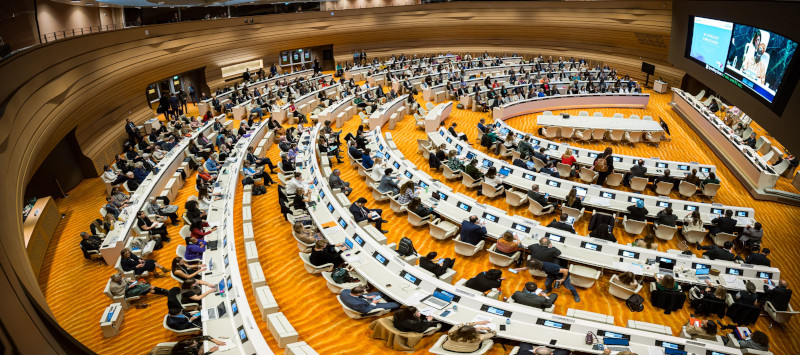Logo of Cyprus’ OSCE Forum for Security Co-operation (FSC) for the 1st Trimester 2024
The logo of Cyprus’ Chairpersonship of the FSC from January to April 2024, designed by the graphist Savvas Thoma, who was engaged by the Press and Information Office, consists of elements, which represent Cyprus’ culture and history of millennia as well as the nature and climate of the island.
From left to right, the armed “Ingot God” from the ancient city of Enkomi in Famagusta is a bronze statue dated to the 12th century BC of a god standing barefoot upon a copper ingot of Cypriot-type in the form of an ox-hide. The God wears a bull-horn helmet and leg-armour, guarding his body with an oval shield held in the left hand with arm outstretched and brandishes in his right hand a pointed lance at the ready. The sculpture is considered tï depict a protector of copper mines of Cyprus. It is noteworthy that the extraction of copper in Cyprus began around 4.000 BC. In antiquity, the island was famous for its production of the metal and this is also why the flag of the Republic of Cyprus has a copper-coloured map of the island in the centre. The statuette can be seen a timeless symbol of security. In the framework of the logo, the” Ingot God” is the guardian of values worth being maintained and protected: environment, cultural heritage, economic activity and, above all, human dignity and human life.
Subsequently, Aphrodite’s marble statue from the 1st century BC, depicts the Goddess, which was most widely worshiped in Cyprus in the ancient times – Cyprus is often called the “island of Aphrodite”. The inclusion of the figure of the female divinity in the logo can also signify the aim of enhancing the role of women in security.
Sun and sea have turned Cyprus into an exceptionally popular destination for tourism. The island enjoys abundant sunshine, even in December and January. Besides, Cyprus ranks first in Europe as regards the cleanness of its swimming waters.
The “Kyrenia Ship”, a wreck of the 4th century BC, symbolises both the importance of shipping for Cyprus as an island state – despite being a small country, Cyprus is a maritime power with the 3rd largest fleet in Europe and the 11th largest in the world – and the naval forces as a component of security. Furthermore, the sails of the ship in the logo have the typical design of the famous laces of the Cypriot village Lefkara. According to a legend, Leonardo da Vinci himself visited Lefkara in 1481 and bought a lace altar cloth, which he donated to Milan cathedral.
Ôhe Sanctuary of Apollon Hylates (God of Woodland), dated from the 3 century BC, is situated in Kourion, one of the most visited archaeological sites in Cyprus.
Finally, the olive tree, which is typical of the Mediterranean flora. The olive branches in the flag of Cyprus are symbols of peace.



